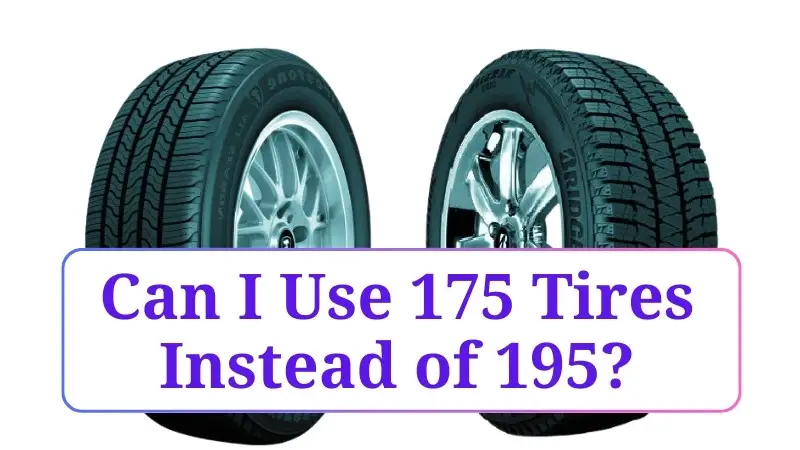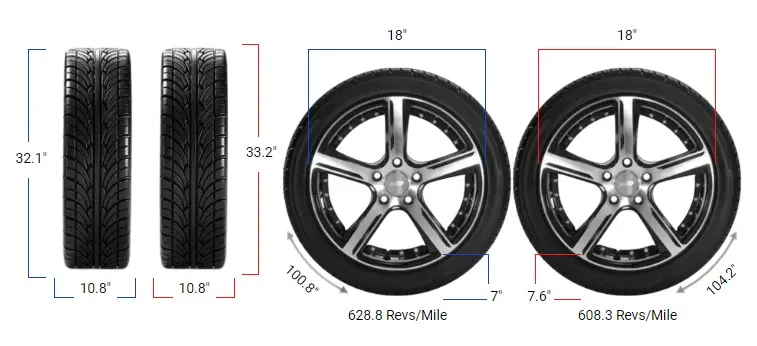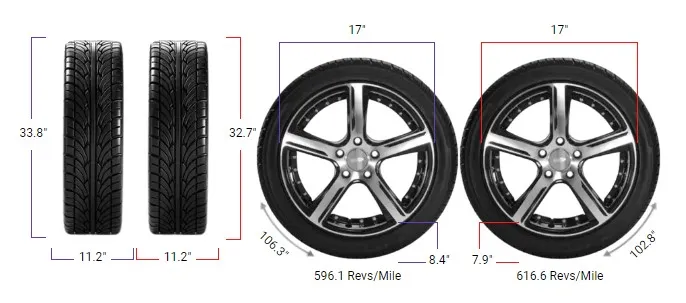Can I Use 175 Tires Instead of 195?

Yes, you can use 175 tires instead of 195, provided certain conditions are met to ensure compatibility and maintain your vehicle’s performance, safety, and comfort.
The key factor in making this swap possible is the overlap in the ideal rim width ranges for both tire sizes.
Tire Compatibility
When considering swapping from 195mm to 175mm tires, compatibility is paramount. According to the data, the ideal rim width range for 195mm tires is 6.0, 6.5, and 7.0 inches, while for 175mm tires, it’s 6.0 and 6.5 inches.
The overlap at 6.0 and 6.5 inches indicates that if your current rims are within this range, they are suitable for both tire sizes. It’s crucial to verify your rim width to ensure it falls within this overlapping range.
Additionally, consult your vehicle manufacturer’s specifications to confirm that the narrower tire size is acceptable for your specific model, as some vehicles may have minimum tire width requirements for safety and performance reasons.

On-Road Impact
Switching to narrower 175mm tires from 195mm can have noticeable effects on your vehicle’s on-road performance.
The narrower tires reduce the contact patch between the tire and the road surface, which can lead to decreased traction, especially during acceleration, braking, and cornering.
This reduction in grip may affect handling and stability, particularly in wet or slippery conditions. On the positive side, narrower tires typically have lower rolling resistance, which can improve fuel efficiency and reduce road noise.
The ride may also become slightly smoother, as narrower tires can better absorb small bumps and imperfections on the road. It’s important to weigh these factors based on your driving habits and priorities.
Off-Road Impact
If you frequently drive off-road, switching to narrower 175mm tires may impact your vehicle’s off-road capabilities.
Wider tires like the 195mm provide a larger footprint, which can enhance traction on loose surfaces such as sand, mud, or gravel.
By switching to narrower tires, you might experience reduced grip in these conditions, potentially making off-road driving more challenging.
However, narrower tires can be advantageous in certain off-road scenarios, such as cutting through snow or mud to reach firmer ground beneath.
Assessing the typical off-road conditions you encounter will help determine whether the switch aligns with your off-road driving needs.

Other Important Factors
Several critical factors should be considered when swapping tire sizes to ensure safety and optimal performance.
Firstly, ensure that the overall diameter difference between the original and new tires is within 3% to maintain accurate speedometer readings and proper functioning of electronic systems like ABS and traction control.
Since we haven’t specified the aspect ratio or rim diameter, it’s essential to match or adjust these parameters accordingly.
Secondly, consider the load index and speed rating of the new tires to ensure they meet or exceed the requirements of your vehicle.
Using tires with a lower load index than recommended can pose safety risks. Additionally, the change in tire width may affect the vehicle’s appearance and fender clearance, so it’s important to check for any potential rubbing or fitment issues.
Consulting with a tire professional or your vehicle’s manufacturer can provide valuable guidance tailored to your specific situation.
Difference Between 175 and 195 Tires
The primary difference between 175 and 195 tires is the width. 195 tires are 20mm wider than 175 tires, affecting aspects like handling, traction, and stability.
Wider tires such as the 195s generally provide better grip, especially in wet conditions, while narrower tires like the 175s may offer better fuel efficiency.
Can I Use 175 Tires Instead of 195?
Yes, you can use 175 tires instead of 195 tires, provided the rim width supports this. The ideal rim width range for 175 tires (6.0-6.5 inches) overlaps with the rim width required for 195 tires (6.0, 6.5, 7.0 inches).
However, using narrower tires may affect performance, especially in terms of stability and grip. Also, the aspect ratio and rim diameter should match your current tires.
If they don’t, ensure that the overall diameter difference stays within 3%, as a larger variation could affect speedometer accuracy and vehicle performance.
Can I Use 195 Tires Instead of 175?
Yes, you can use 195 tires instead of 175 tires. The ideal rim width range for 195 tires (6.0-7.0 inches) overlaps with the range for 175 tires (6.0-6.5 inches), ensuring a proper fit.
The wider tires will offer better handling and traction but may slightly reduce fuel efficiency. It’s essential to check that the aspect ratio and rim diameter of the replacement tires match your existing setup to maintain optimal performance.
Ensure that the overall diameter difference is within 3% to avoid negatively affecting speedometer accuracy and vehicle handling.
Can You Put 175 Tires on 195 Rims?
Yes, you can put 175 tires on rims designed for 195 tires. The ideal rim width range for 195 tires (6.0-7.0 inches) overlaps with the range for 175 tires (6.0-6.5 inches), allowing for a proper fit.
However, using narrower tires on wider rims may affect the tire’s ability to perform optimally, especially in terms of handling and stability.
Can You Put 195 Tires on 175 Rims?
Yes, you can put 195 tires on rims designed for 175 tires. The ideal rim width range for 175 tires (6.0-6.5 inches) overlaps with the rim width requirement for 195 tires (6.0, 6.5, 7.0 inches).
However, fitting wider tires on narrower rims may impact handling, tire wear, and overall comfort. It’s essential to ensure a balanced setup to avoid potential performance issues.
Our Observation
Having personally switched from 195mm to 175mm tires on my vehicle, I can share some insights from my experience.
One of the immediate benefits I noticed was improved fuel efficiency; the car seemed to consume less fuel on my regular commutes, which was a pleasant surprise.
The ride quality also felt slightly smoother, especially over rough patches of road, likely due to the narrower tires absorbing bumps more effectively.
However, I did observe a slight decrease in handling precision, particularly during sharp turns and in wet conditions. The car didn’t feel as planted on the road as it did with the wider tires.
Additionally, during a weekend trip that involved some gravel roads, the reduced traction was noticeable, and I had to drive more cautiously.
Overall, the switch to 175mm tires had its pros and cons. If fuel economy and comfort are your primary concerns, the narrower tires can be a good choice.
However, if you prioritize handling and traction, especially in challenging driving conditions, you might prefer to stick with the wider 195mm tires.

Rifat Al Mahmud is the esteemed CTO of TireSizeCompare.com, an innovative online platform for tire size comparisons and information. With deep expertise in technology and development, Rifat leads his team in enhancing user experience and expanding the website’s capabilities, ensuring it remains a premier resource for drivers and automotive enthusiasts worldwide.


